TT Journal, ISSUE 6, September 2023
By Isa Juchniewicz
I’m recalling my childhood – precious fragments of a time when life was filled with innocent wonder and boundless imagination; living each day with the authority to turn any potentially-mundane moment into a playground for as long as I’d be willing to do so. My sister and I possessed the power of a seemingly endless tap of creativity, regardless of whatever toys we did or did not possess. There are memories of portals to spaceships, and a safe haven underneath the bluest of webbed blankets above; cold light emanating (or radiating, depending on the fictitious narrative we were currently abiding by) from our very own atmosphere just barely above us. For as long as we could, we kept this spirit of Play alive and frequently present. But things changed, as they tend to. Somehow, this sacred space and time began to elude our adolescent selves. When we could manage to schedule time, which typically belonged to the ritual that was playtime, it seemed to become something else – and it looked a bit different as well – with its gaming devices, cameras, computer and TV screens. I still remember our first computer, the excitement of taking a seat by the dedicated tech corner in the living room to play Space Cadet 3D Pinball on the now outdated device (fig. 1).

Fig. 1 Space Cadet 3D Pinball
Play began emitting a new light (a zinc-cadmium phosphorus one). Unsure how this might transform or tarnish our imaginations, we invited the multifaceted nature of exploring something new. Looking back at the moments in which these technologies first entered my life and my sister’s life, I wonder how much the nature of these modern marvels influenced our way of being and developing new ideas – instant gratification with the ubiquity of screens and endless media awaiting our consumption, virtual realities that required less of our imagination but more of our cooperation. While captivating, they somehow isolated me from the tangible, sensory experiences my sister and I had – experiences so integral to our human nature. In the face of these challenges and often discussed fears, I began to wonder how to reach a place where the potential of those ever-new technologies can enhance, not replace, the essence of play.
The result of these reflections is an artistic research I began this year titled Homo ludens cum arte technica (from now on Hlcat) that will span across 3-4 years. This research explores ways of playing and being playful with new media, and creates frameworks of collaboration at a micro level, focusing its activities mainly in small towns and villages. The aim of the project is to encourage experimental, collaborative, creative and playful making between people of various artistic backgrounds, sensibilities, ages and experience with technology. Cosmic synthesis, as the first part of Hlcat, marks the beginning of this journey. In the first week of July 2023, together with two other artists, Michael Lozano and Rigo Gallardo, we traveled to the small Polish town of Suchowola – a town that is quite familiar to my inner child – with the following questions in mind: How to play with new media? How to escape a product-oriented engagement with technology? How to create an environment that encourages play with technology? To answer these, we embarked on a space journey. The goal of that interstellar travel: to find Homo ludens, the playful echo reverberating through space (fig.2).

Fig. 2 Visual representation of Homo ludens
Coined by Dutch cultural historian Johan Huizinga in his book Homo ludens (1938), the term introduces the concept of the “playing / playful (hu)man”. Huizinga sums up the formal characteristics of play as follows:
- Play is voluntary.
- Play is limited in time and space.
- Play is governed by rules.
- Play is separate from “reality/real life”.
- Play is make-believe.
- Play is uncertain.
- Play is immersive.
With this set of guidelines in mind, a narrative for the artistic workshop / playground was developed that used technology as an integral part of its structure. After meeting the teen musicians from the town’s Youth Brass Orchestra during a rehearsal a couple of months prior to the project, and a brief introduction to the artistic research, several of them declared their interest in playing with us. After establishing a collaboration with GOKSiT – Gminny Ośrodek Kultury, Turystyki i Sportu (Communal Center of Culture, Tourism and Sport) in Suchowola, we were offered the local cinema as the dedicated space to design our playground. Joined by three teen musicians from the orchestra: Aleksandra Szubzda (clarinet), Maria Bernatowicz (trumpet) & Patrycja Rudzińska (trombone), we boarded the stage at Kino Kometa (Cinema Comet) and left our familiar atmosphere. The workshop was divided into three days, each of them three-hour-long, during which (through our cosmic narrative) we explored the relationship between sound and light, the body and light, the body and sound.
Each day before entering the stage / spaceship, the space cadets were asked to make a verbal agreement:
“when you enter the stage, you become part of a spaceship traversing the universe;
when you enter the stage, you leave all your baggage and worries behind;
when you enter the stage, you are free to develop an alter ego and become whoever you want to be;
when you enter the stage, you promise not to spoil the fun for anyone else;
only when you leave the stage, when you leave the spaceship, are you allowed to return to reality;
do you agree to these terms?”
After entering the stage, the light was turned off, the sound faded in, and an automatic screen was moved down, cutting the participants off from the “real world”(fig. 3), immersing them in the land of make-believe.

Fig. 3 Cosmic synthesis – entering the spaceship
I began to tell them the story of the universe – the symphonic tale of Homo sapiens and his two children: Homo techne and Homo ludens. Over the course of our three light-day long space mission, the participants made sure that our ship was functional and that its technology would allow us to first find Homo techne residing on the Unknown Planet, and later on their playful sibling – Homo ludens. Each day featured a little tutorial that the participants had to complete, followed by an exercise that humanized their relationship to the technology. During the first light-day the cadets were presented with flashcards / instructions that allowed them to make a LED light blink using a microcontroller, certain electronic components and a code copy-pasted into the appropriate software.
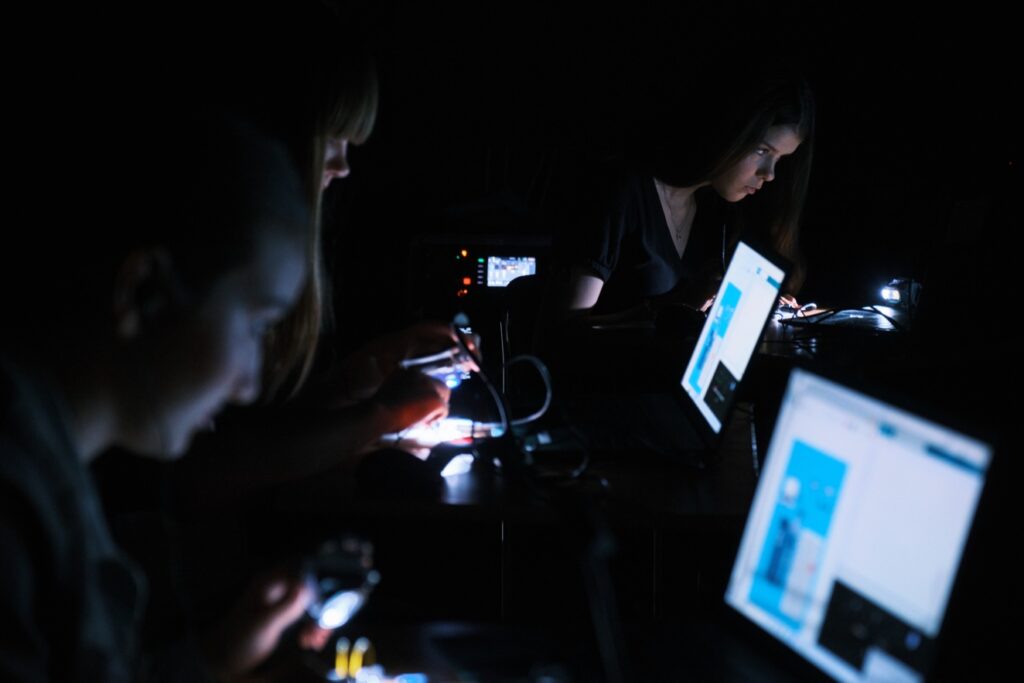
Fig. 4 Cosmic synthesis – Day 1
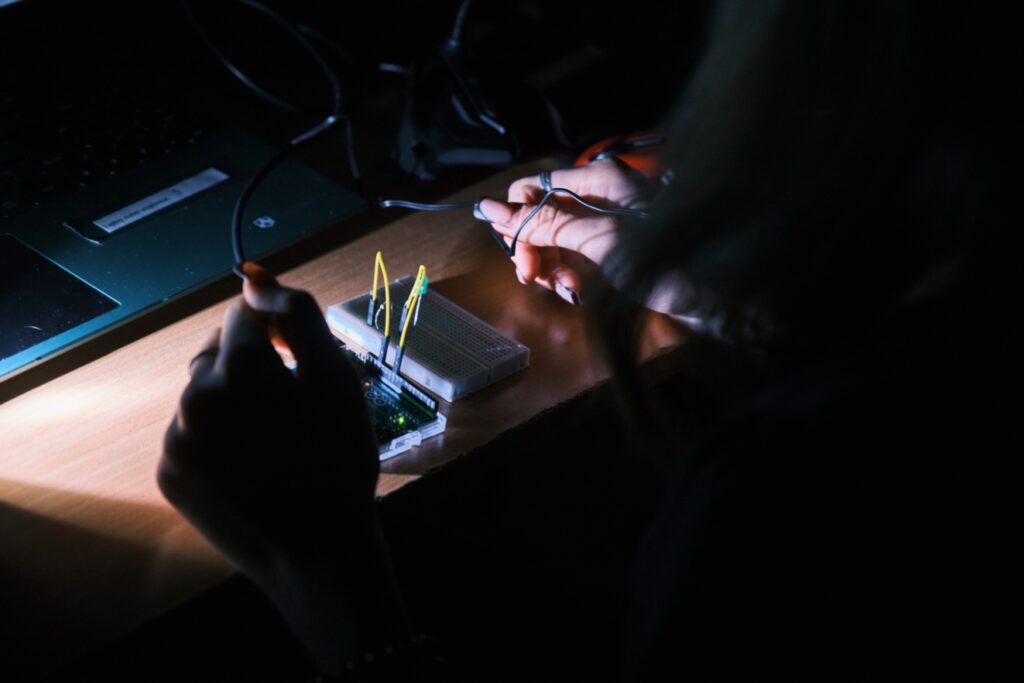
Fig. 5 Cosmic synthesis – Day 1
The code was prepared beforehand, and the participants were not required to know the programming language. Later, they were asked to close their eyes, measure their pulse, and change the values in the code to find a rhythm of the light that would correspond to their pulse; From body to numbers to light. I found this element of materializing something bodily through technology incredibly humanizing in regards to the tech used. Something that allowed for the tangible, the sensory to make a return to Play. The participants in their feedback also voiced that that particular aspect was the most interesting to them.
Those type of exercises focusing on materializing something immaterial with the help of technology carried on for the rest of the space journey; whether it was imagining yourself in different situations, translating emotions into sound that fueled our ability to travel through the depths of space (the participants’ improvisation with instruments was able to affect visuals representing different landscapes of the Unknown Planet, fig 6. fig 7), or materializing your pulse and memories expressed with your voice through light (fig. 8).
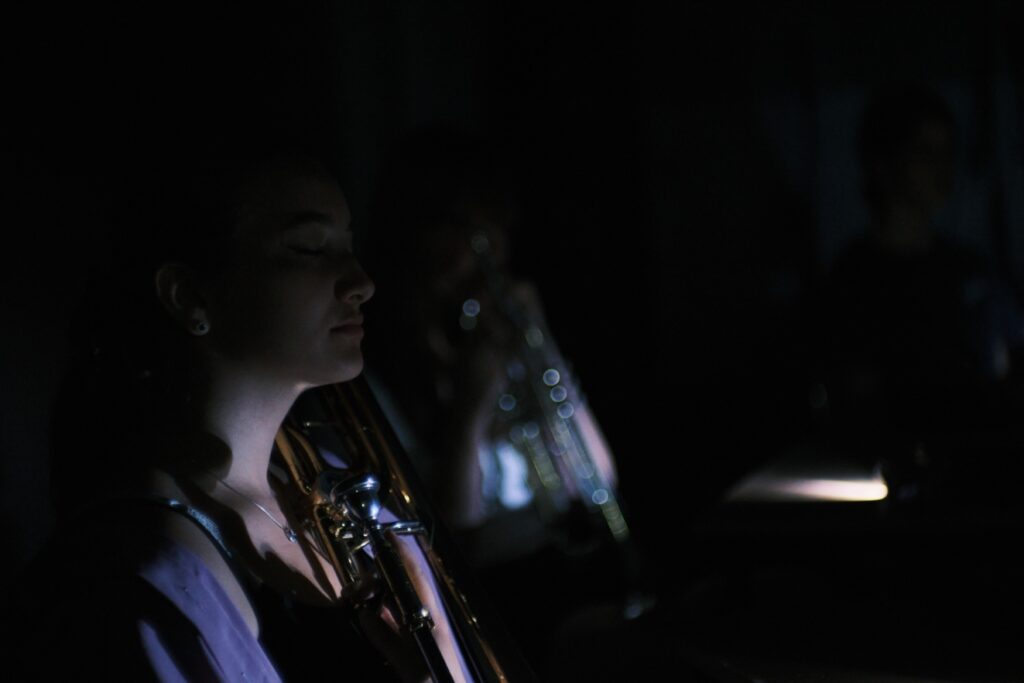
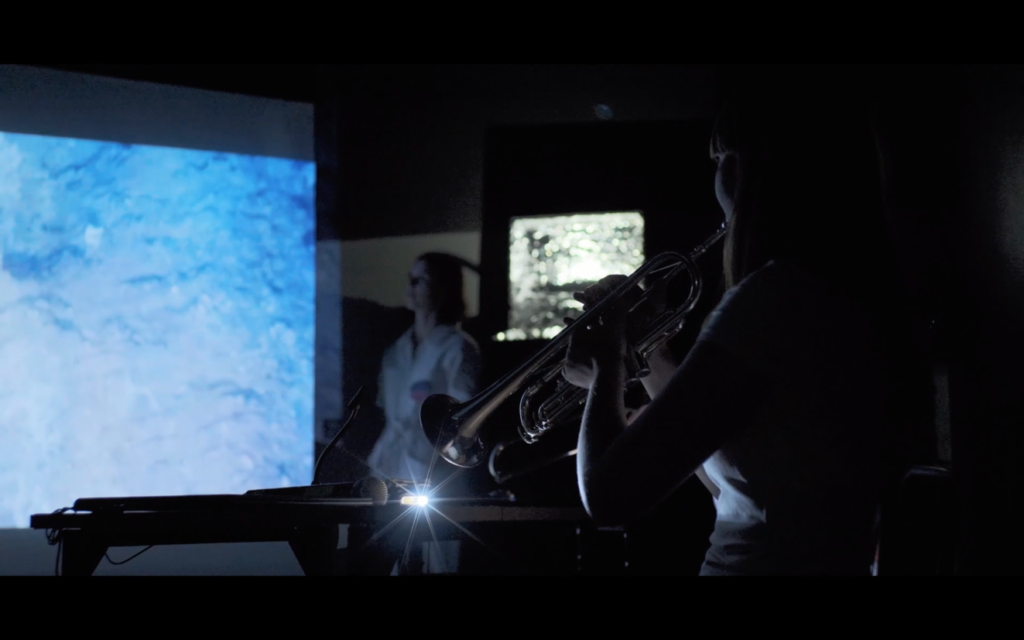
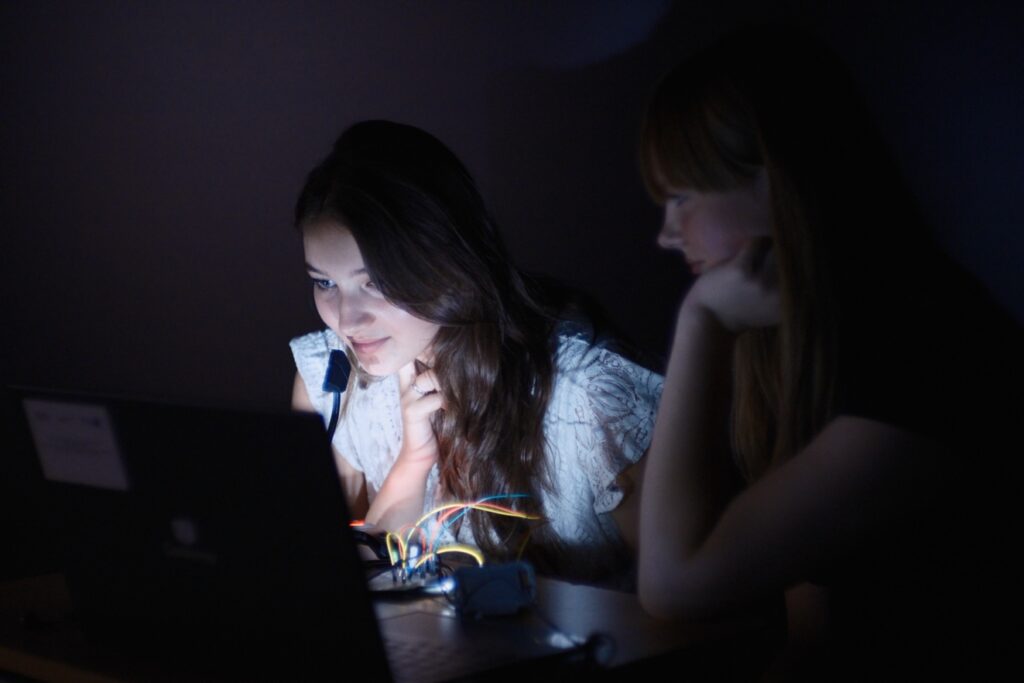
From body to sound to light. Relating the technology to the body gave the participants some authority in this make-believe scenario. While we designed an environment and narrative that encouraged playfulness, the possibility for them to use their own bodies, memories and feelings, to travel back in time and experiment with different perspectives seemed indispensable – an element that I was uncertain about in the beginning, but eventually proved to be immensely important. As Huizinga stated in his book, play is uncertain. In discussions with the participants, we concluded that the element of the unknown, of magic, is essential to feeling engaged in play. However, it also seems a bit tricky when working with technology because without a certain level of knowledge, one often feels intimidated to approach something that feels even remotely electronic. The challenge was to design a format for the teens in which gaining knowledge about the tech used is not the priority, but by providing them with bits (that are understandable enough), they could play and still be able to interact with the media. Without the uncertainty and suspense, we would remove the potential of discovery, challenge and surprise. Just think of the way you interact with your phone and the joy from discovering something unexpected while “playing” with it. Play needs to captivate. It needs to evoke a sense of intense involvement and engagement. I believe that any human being can probably locate a moment of losing track of time, because the activity they were engaged in so immersively cut them off from the real world. Yet, when traveling back to my childhood I realize how important the element of creating the environment in play is. While the activity itself can be incredibly engaging, it can at times also become quite repetitive if your heart is not fully in it. Creating an environment or a narrative, one as simple as space travel, allowed for the participants to feel immersed and cut off from reality. Funnily enough, it also justified some tech problems we had, which to our space cadets felt like a normal occurrence on a spaceship.
After returning back to Earth, and leaving the town of Suchowola, we began wondering how to continue developing this workshop. Huizinga’s characteristics of play were applicable in our experiment and now seem to me necessary components of playing with technology (or developing a playful relationship with technology). However, as much as the first part of Hlcat answered some of my initial questions, it opened yet another Pandora’s box. What could we improve or introduce? What would it look like to conduct the same experience with different age groups? And how would our role in supporting their imagination change? Does there always need to be a mediator — a figure in-between – that helps to navigate the relationship of technology, person and play, or is there a way of approaching it on equal footing? Lastly, can this workshop exist as an independent experience in the form of something resembling a board game, and how would the participants’ perception of play change in that scenario? Mission updates will follow. Over.
Thanks to Michael Lozano and Rigo Gallardo whose observations and reflections assisted me in writing this text.
Cosmic synthesis was developed in collaboration with GOKSiT in Suchowola.
Credits:
Concept & Direction: Isa Juchniewicz
Sound Design: Michael Lozano & Rigo Gallardo
Photo & Video Documentation: Michael Lozano
Isa Juchniewicz is a visual artist and educator based in Prague. Working primarily in new media, video, performance & telematics, she explores non-traditional frameworks of belonging. By questioning how physical & virtual space can interact with each other, she aims to design experiences in which one’s senses can be extended and positively confused.
isajuchniewicz.com
IG: heyeesa
